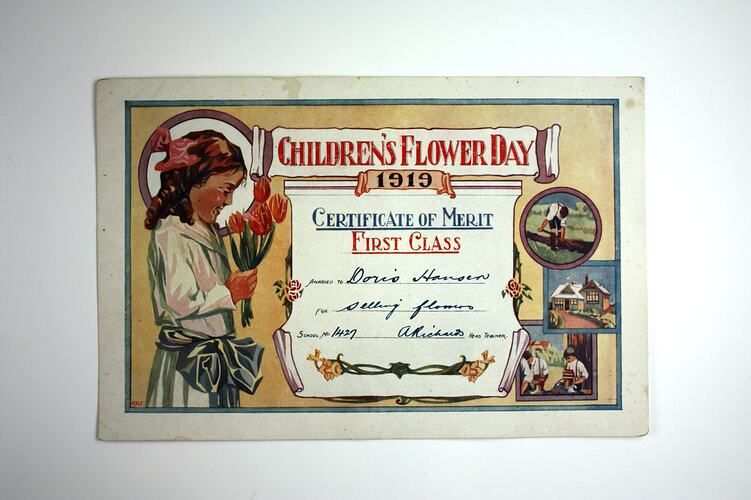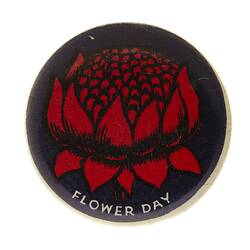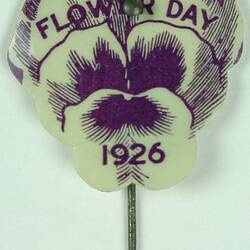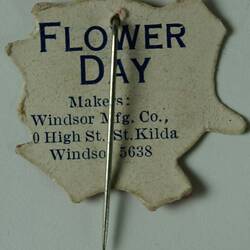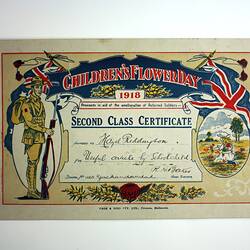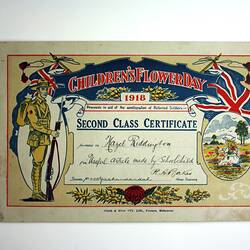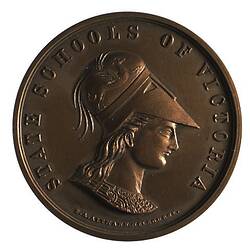Summary
Alternative Name(s): Certificate of Merit
Children's Flower Day certificate, presented to a pupil at Port Melbourne Primary School, for 'selling flowers', in 1919. The contrast between the open environment depicted on the certificate (spacious grounds, new building) and the local environment in Port Melbourne in 1919, when the certificate was earned, is an interesting one.
The receipient, Doris Hansen, was born in November 1905. She attended Port Melbourne Primary School, even after she moved to South Yarra.
Flower Day had its origins in the League of Young Gardeners, created in Victoria in 1916 to 'swell the war relief fund, by cultivating garden plots at home'. From this movement sprang several 'Flower Days' which raised £126,354 for war relief. In 1916, the Victorian Education Department instructed teachers to promote gardening initiatives, and announced that there would be a November Flower Day. The main event of the Day was to be a fund-raising flower show from school gardens - 'Let the children feel that the show is to be their show', advised Supervisor of School Gardening, Cyril Isaac. At schools, the day consisted of morning lessons on war-related topics; in the afternoon schools set up street stalls to sell bouquets and button holes. The main show was not held in 1918 due to stringent war economies, but £50,000 was still raised. The event petered out after World War I.
Physical Description
Coloured certificate printed on cardboard. Certificate shows a young girl with red hair, pink bow in her hair, ringlets, white dress with dropped waist and blue satin bow, with a bunch of red tulips. On right side of the certificate are three small images: boy digging furrow; small country school with extensive garden, and two boys possibly potting plants. There is a scroll at top, and the text of the certificate is on a second scroll.
Significance
The League of Young Gardeners was created in Victoria to 'swell the war relief fund, by cultivating garden plots at home.' From this movement sprang the three 'Flower Days' which raised 126,000 pounds for war relief. The certificate is a memento of that voluntary effort by school children, part of the enormous fund- raising activity during World War I. It is evidence of socialisation of children, gender division of work for children, suburban images, and a swing away from war preoccupation to domestic ones at the end of the War. Earlier such certificates showed a soldier; although the money raised was still to go to war relief, the soldier is absent in the 1919 certificate. The suburbanised, pastoral imagery on the certificate reflects the world the soldiers were to return to, and is far from the horrors of war.
More Information
-
Collecting Areas
-
Acquisition Information
Donation from Mrs Margaret Weatherley, 19 Aug 1996
-
Date Made
-
Place & Date Used
Port Melbourne, Greater Melbourne, Victoria, Australia, 1919
-
Inscriptions
Printed text: CHILDREN'S FLOWER DAY/1919/CERTIFICATE OF MERIT/FIRST CLASS/AWARDED TO Doris Hansen/FOR selling flowers/SCHOOL NO. 1427.
-
Classification
-
Category
-
Discipline
-
Type of item
-
Overall Dimensions
24 cm (Length), 16 cm (Height)
-
References
Ernest Scott: Official history of Australia in the war of 1914-1918. Vol. XI, p.733 - 735 Information on Flower Day from the Australian War Memorial web site - record for REL39124 - Fundraising badge : Children's Flower Day 1919 Peace Year, [Link 1] accessed 27/9/2012; and Rosalie Triolo, 2012. 'Our Schools and the War', pp. 88-90.
-
Keywords
